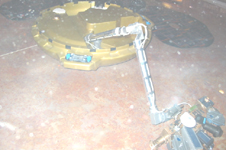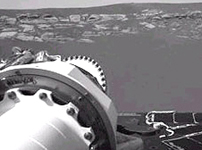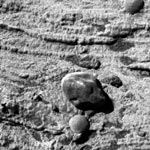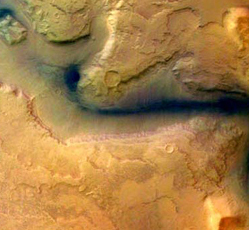Mars

More evidence for water on Mars
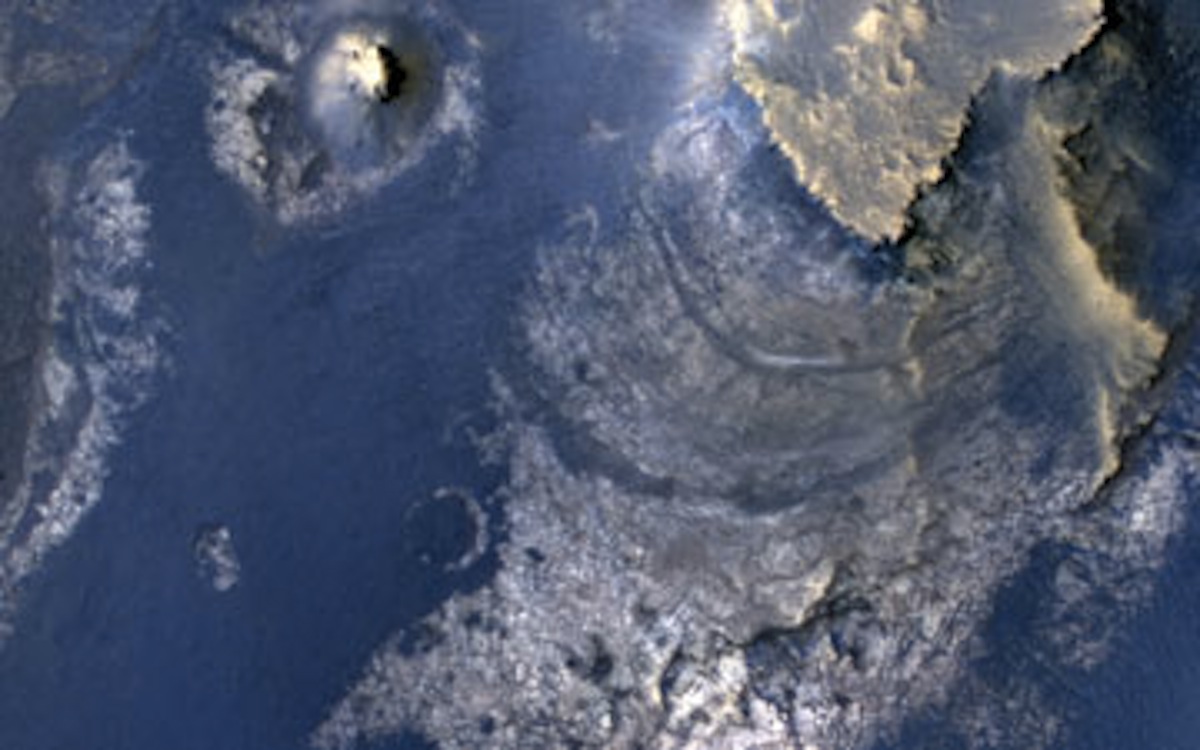 (from NASA): A NASA spacecraft, MRO, is providing new evidence of a wet underground environment on Mars that adds to an increasingly complex picture of the Red Planet's early evolution.
(from NASA): A NASA spacecraft, MRO, is providing new evidence of a wet underground environment on Mars that adds to an increasingly complex picture of the Red Planet's early evolution.
The McLaughlin Crater is 57 miles (92 kilometers) in diameter and 1.4 miles (2.2 kilometers) deep. McLaughlin's depth apparently once allowed underground water, which otherwise would have stayed hidden, to flow into the crater's interior.
More updates on Mars
Latest News: Mars has more "heavy water" than Earth. Samples scouped up from the ground by the Curiosity rover have revealed heavy water, carbon and chlorine. (Heavy water has deuterium in which the hydrogen has two protons instead of the one in ordinary water, in its nucleus).
Mars is fourth from the Sun of the four main rocky planets. It orbits the Sun in 686 to 687 Earth days, which is about two Earth years. Its rotation is only a little longer than Earth, 24 hours 37 minutes and 23 seconds, and in the same direction so a Martian day is similar to an Earth day. Mars has nearly the same inclination of its rotational axis as Earth 25 degrees 12 minutes and Earth leans over at 23 degrees and 26 minutes, so Mars has similar seasonal changes to Earth, but lasting twice as long because its orbit round the Sun is twice as long.
Mars is only about half the size of Earth. Its radius across its equator is about 3400 kilometres. Its mass is one tenth that of Earth. Its mean density is about two thirds that of Earth, 3.93 x 103 Kgm. The mean density of Earth is 5.52 x 103 Kgm.
When Mars can be seen it can be very bright as it approaches near to the Earth and looks red. This led to its associations with the God of War to the people of the near East; Chaldeans - Nergal; Persians - Pahlavania Siphir; Greeks - Ares, from the words meaning to kill, or disaster; who associated it with the metal iron.
 -The symbol used for Mars on astronomical tables was also the sign used by ironmongers and the sign for "male".
-The symbol used for Mars on astronomical tables was also the sign used by ironmongers and the sign for "male".
Mars was also associated with the colour red, an oblong shape, the number seven, as well as the God of War. In fact the red colour is due to oxidised iron in the Martian rocks. To the Chinese Mars was associated with the element of fire, the direction of south (in which it is seen) and was called the "Fitful Glitterer".
Orbit of Mars
As Mars was observed night after night travelling along the ecliptic, it could be seen to spend some weeks apparently going backwards, before continuing in the usual direction again. All the planets were observed to do this, but it is more easy to see this in Mars.
This behaviour of the planetary motions caused great problems to astronomers in the Near East and Mediterranean areas who had inherited and accepted as dogma, the Pythagorean philosophy that all movements in the heavens must be perfectly circular. The planets were thought to be actually fixed to spheres, like parts in a giant astronomical clock or armillary.
The problem of spherical motion to fit the actual observed motions of the planets was solved by assuming they moved in small circles round a larger circle, and not round the centre of the circle either. This idea was perpetuated by the 2nd century AD astronomer in Alexandria in Egypt, Claudius Ptolemaeus (Ptolemy) in his book which came to be known as the Almagest, and was translated and became the standard astronomical handbook for centuries. This was because the system worked mathematically. It would in fact have worked for any real shape of orbit, square orbits even.
Ptolemy's system should have been challenged by the contacts with Chinese astronomers who worked together with Islamic, Indian and Western astronomers in the great 13th - 14th century Mongol observatories in Persian and China. However the Ptolemaic system was adopted by Chinese astronomers - for their calculations.
In the fifteenth and sixteenth centuries improved measurements of parallax with better instruments showed that comets and apparent new stars (supernovae) were above the Moon's sphere, and therefore the heavens could not be fixed and solid. Copernicus quoted the example of the Pythagoreans when he put the Sun in the centre of the universe in his system which otherwise kept to the circles of the Ptolemeic method of calculating the orbits.
At the end of the 16th century, Johannes Kepler was working for Tycho Brahe in Bohemia, to compile what what to be called the Rudolphine tables after the Emperor Rudolph II who funded the project. Kepler was given the job of calculating the orbit of Mars. He continued this work after Brahe's death, as what he found was very interesting. The orbit of Mars was an ellipse.
At the end of the 17th century the telescope had been developed and first used to observe the celestial bodies in the night sky. First the Moon - was discovered to be a world with mountains and other features. Then the planets were seen to be worlds too.
Galileo's discovery and observations of four moons orbiting Jupiter seriously threatened the traditional system of the universe and brought him up against the Catholic Inquisition. Worrying - as a few years earlier Bruno had been imprisoned and tortured for 8 years by the Vatican for promoting the belief that the Earth was just one of an infinite number of worlds, and then was burned to the stake with an iron spike hammered through his jaw and tongue.
It was not until November 2nd, 1992, that the Vatican, after thirteen years of deliberation by a committee set up by the Pope, admitted that it had been wrong to condemn Galileo in 1633 for backing the theory that the Earth (and the other planets) orbit Sun.
Telescope observations
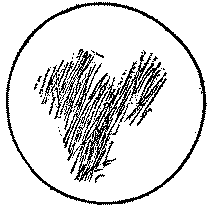 Through their telescopes it was possible for astronomers to discern features on Mars. Though not very clearly. Darker areas in the centre of Mars can be seen through a small telescope and also the bright white polar ice cap.
Through their telescopes it was possible for astronomers to discern features on Mars. Though not very clearly. Darker areas in the centre of Mars can be seen through a small telescope and also the bright white polar ice cap.
In 1638, the Italian Franciscus Fontana (1608 - 69) noticed that Mars shows phases like the Moon, as it orbits the Sun. Christiaan Huygens (1629 - 93) drew what he thought to be features on Mars. These observations showed that Mars was a planet as the Earth was, and therefore perhaps inhabited by Martians.
With his nephew Giacomo Maraldi (1646 - 1729) Cassini studied Mars from 1672. They thought they could see clouds as well as surface features, and also saw the polar caps. The Italian astronomer Giovanni Cassini (1625-1712) was founder of a dynasty that ruled the Paris observatory until they were kicked out by the French Revolution.
William Herschel (1738-1822) and his sister Caroline, also noticed the polar caps of Mars when they looked at the planet between 1777 - 1784). Ice caps indicated water, clouds indicated atmosphere, both seem to indicate that Mars could be inhabited.
Mars does have an atmosphere similar to Earth's, but it is very much thinner. It contains carbon dioxide, nitrogen, argon and oxygen but in different proportions to Earth's atmosphere. The Martian atmosphere is 95% carbon dioxide.
Mapping Mars
Mapping Mars meant establishing a prime meridian of longitude on Mars.
On Earth, the longitude of the Royal Observatory in Greenwich is defined as the "prime meridian," or the zero point of longitude. Locations on Earth are measured in degrees east or west from this position. The prime meridian was defined by international agreement in 1884 as the position of the large "transit circle", a telescope in the Observatory's Meridian Building. The transit circle was built by Sir George Biddell Airy, the 7th Astronomer Royal, in 1850. (The current definition of the prime meridian is in reference to orbiting satellites and Very Long Baseline Interferometry (VLBI) measurements of distant radio sources such as quasars. This "International Reference Meridian" is now about 100 meters east of the Airy Transit at Greenwich.)
For Mars, the prime meridian was first defined by the German astronomers W. Beer and J. H. Madler in 1830-32. They used a small circular feature, which they designated "a," as a reference point to determine the rotation period of the planet. The Italian astronomer G. V. Schiaparelli, in his 1877 map of Mars, used this feature as the zero point of longitude. It was subsequently named Sinus Meridiani ("Middle Bay") by Camille Flammarion.
When Mariner 9 mapped the planet at about 1 kilometre (0.62 mile) resolution in 1972, an extensive "control net" of locations was computed by Merton Davies of the RAND Corporation. Davies designated a 0.5-kilometer-wide crater (0.3 miles wide), subsequently named "Airy-0" (within the large crater Airy in Sinus Meridiani) as the longitude zero point. (Airy was named to commemorate the builder of the Greenwich transit.) This crater was imaged once by Mariner 9 (the 3rd picture taken on its 533rd orbit, 533B03) and once by the Viking 1 orbiter in 1978 (the 46th image on that spacecraft's 746th orbit, 746A46), and these two images were the basis of the Martian longitude system.
The Mars Global Surveyor (MGS) Mars Orbiter Camera (MOC) has attempted to take a picture of Airy-0 on every close overflight since the beginning of the MGS mapping mission. Nine attempts were required - the spacecraft did not pass directly over Airy-0 until almost the end of the MGS primary mission, on orbit 8280 (January 13, 2001).
You can see the current maps of Mars here.
Early maps were a little fanciful.
The map by Richard Proctor which he drew in 1867, was very detailed, but never acceptable internationally, as all the biggest features were named after Englishmen, some unknown to others than Proctor.
Followers of Mars
In 1877, Asaph Hall, from Washington, USA, (1829 - 1907) discovered Mars's two little satellites. They were called after the attendants of Ares, God of War in the Iliad.
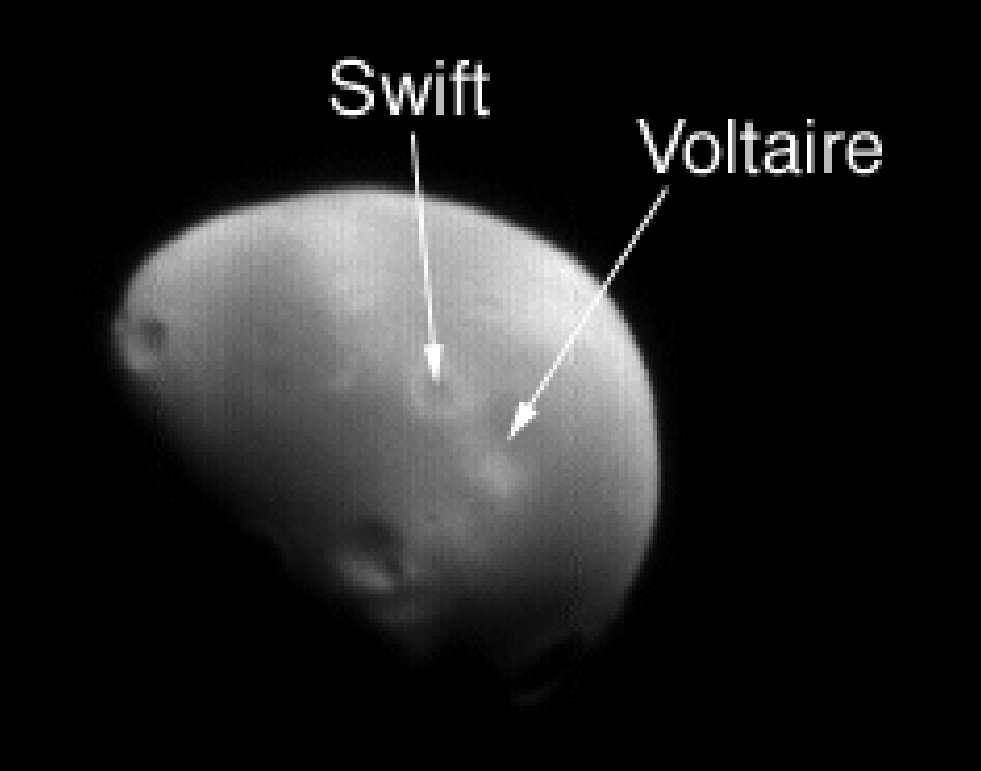 Deimos (Terror)
Deimos (Terror)
- is shown in this photo taken August 2006, with two features labelled.
It is the outer of the two satellites, and smallest at about 15 x 12 kilometres.
 Phobos (Fear)
Phobos (Fear)
part of which is shown in this photo, is about 27 x 21 kilometres. Density about 28.1 cm³.
They are both irregular shapes and have lots of craters from meteoric bombardment covered by regolith (sand and dust). The largest crater on Phobos is ten kilometres in diameter. Phobos also is crossed by many striations. The battering these two little bodies have received is at least partly responsible for their irregular shapes. The ejected material thrown off by a meteor hitting the surface goes round Mars on its own and comes back again to land on the surface as regolith. Both satellites are very dark and as old as most of the solar system. The period of rotation of Phobos is less than the axial rotation of Mars so it comes up more than once a day, but that of Deimos is greater as it has a longer orbit. The orbital radius of Deimos is 23,460 kilometres, and of Phobos, the closest to Mars and larger body, 9300 kilometres. The rotation period of the satellites is synchronous with their orbits as a result of tidal friction and both keep the same face turned to Mars. The orbits are almost circular, on the plane of Mars's equator, and in the same direction as Mars's rotation. Deimos's month is 30 hours, 18 minutes. Phobos's month is only 7 hours 39 minutes so it rises twice a day.
Canals on Mars
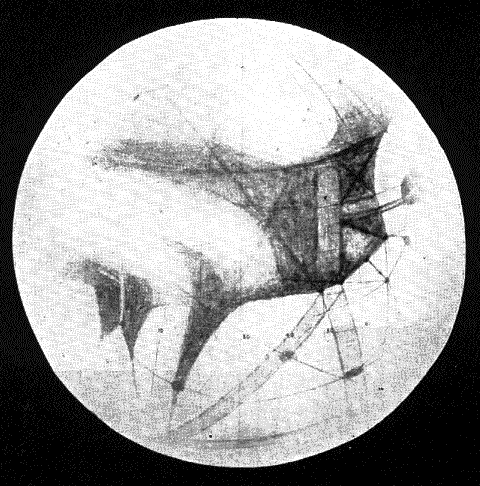 In 1877, Giovanni Schiaparelli (1835 - 1910) named all the features he observed in Latin, which was internationally acceptable. He saw lines running across Mars from darker areas which he thought were seas. He called the lines Canali (Canals). He made complicated maps of these canals. Other astronomers also started drawing canal systems on Mars, which could not be seen in the photos of Mars. (Such features would never have been visible from Earth even through the most powerful of the telescopes available at the time).
In 1877, Giovanni Schiaparelli (1835 - 1910) named all the features he observed in Latin, which was internationally acceptable. He saw lines running across Mars from darker areas which he thought were seas. He called the lines Canali (Canals). He made complicated maps of these canals. Other astronomers also started drawing canal systems on Mars, which could not be seen in the photos of Mars. (Such features would never have been visible from Earth even through the most powerful of the telescopes available at the time).
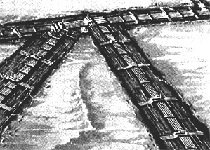 The idea of canals on Mars triggered off by Schiaparelli was a popular and exciting one in the 19th century. Canals were one of the greatest 19th century technological achievements. Canals meant an advanced civilization of Martians. Once the idea got hold others saw canals on Mars too. The idea was popularised by French writer Camille Flammarion, (1842 - 1925) in a number of books about life on other planets. It inspired an extremely wealthy amateur astronomer Percival Lowell (1855 - 1916). The caption to this picture of the canals on Mars did admit it was not an actual photo but an "artist's impression".
The idea of canals on Mars triggered off by Schiaparelli was a popular and exciting one in the 19th century. Canals were one of the greatest 19th century technological achievements. Canals meant an advanced civilization of Martians. Once the idea got hold others saw canals on Mars too. The idea was popularised by French writer Camille Flammarion, (1842 - 1925) in a number of books about life on other planets. It inspired an extremely wealthy amateur astronomer Percival Lowell (1855 - 1916). The caption to this picture of the canals on Mars did admit it was not an actual photo but an "artist's impression".
Lowell had the funds to build his own professional observatory at Flagstaff, Arizona. He published books on his observations of Mars, in which he concluded that the canals had been made by an advanced civilization trying to save their drying, dying world, by a system of canals carrying water from the icecaps to irrigate the planet. He drew diagrams showing this system and naming the canals. He observed and noted double canals too. A whole system.
Strangely the illustrations of Martian canals - which became very elaborate as the idea was taken up by others, never show anything else - no boats, buildings etc. only canals and the locks to regulate them, as in the picture from a book published in the 1930s - of which only a small section of the illustration which is the frontispiece of this book, is shown.
Probes to Mars
The first probe to Mars, called Mars 1, was launched by Russia in 1962. It by-passed Mars but communication failed. It was followed by Zond 2, 1964 which failed. Zond 3 in 1965 transmitted pictures from a distance.
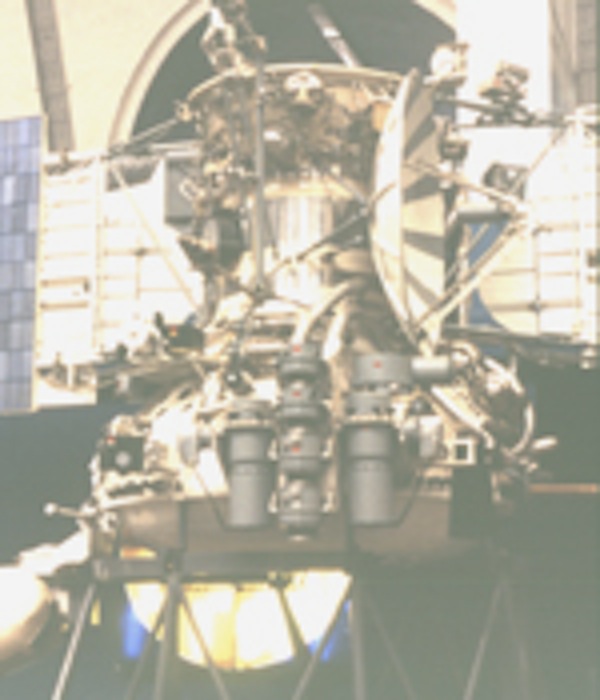 In 1971, Mars 2's lander failed, but Mars 3 (see picture)was successful. It orbited Mars and launched a lander which transmitted data. But it only lasted for 20 seconds and it was killed off by a dust storm. The orbiters continued to send back pictures but these were spoiled by the massive dust storm which hid the features.
In 1971, Mars 2's lander failed, but Mars 3 (see picture)was successful. It orbited Mars and launched a lander which transmitted data. But it only lasted for 20 seconds and it was killed off by a dust storm. The orbiters continued to send back pictures but these were spoiled by the massive dust storm which hid the features.
These successes were followed by Mars 4 and Mars 5 launched 1973, and Mars 6 and Mars 7.
It was now possible to map the surface of Mars together with the data gathered by the Russian Mars probes and Nasa's Mariner 6 and 7 in 1969, and Mariner 9 in 1971.
In 1975, Nasa sent Viking 1 and Viking 2 to Mars. They landed and transmitted pictures from the surface. The probes found no evidence for life but the pictures showed the dusty red surface covered with red rocks under a pink sky. At last we knew what it was like on Mars.
Features on Mars
Mars is said to have four main types of terrain:
- Ancient, studded with craters, where little geological activity must have taken place.
- Younger, volcanic plains.
- Large volcanic structures.
- Extensive sedimentary deposits.
Mars is too small to have generated enough internal heat to sustain a great deal of plate tectonics.
Evidence that the crust has not moved very much are the huge volcanoes.
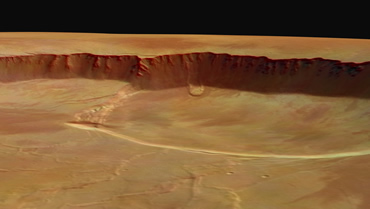 | Olympus Mons, the biggest, is the highest mountain in the Solar System - and would totally cover the British Isles. This is a view of its craters from Mars Express in 2004. |
The height of mountains on Earth is measured from sea level. On other planets the height is measured from a zero contour, which is on Mars 6.1 x 102 Pa atmospheric pressure level.
Olympus Mons by these measurements is over 25 kilometres or 17 miles high. And it is over 550 kilometres across at its base.
The hot spot which caused the eruptions of Olympus Mons and its companion volcanos is similar to the hot spots on the Earth's mantle such as those which caused the Hawaiian Islands. On Earth, the crust moves on over the hot spots, leaving a chain of volcanoes, this is how the chain of Hawaiian Islands has formed. On Mars the crust is thicker and hasn't moved much for a long time resulting in these huge ancient volcanos.
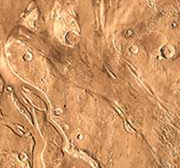
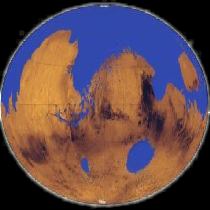 A very interesting feature is what look very much like river valleys. And yet there cannot have been much in the way of surface water on Mars perhaps for at least 3,000 million years, as the atmospheric pressure is just at the point where liquid water cannot be supported.
A very interesting feature is what look very much like river valleys. And yet there cannot have been much in the way of surface water on Mars perhaps for at least 3,000 million years, as the atmospheric pressure is just at the point where liquid water cannot be supported.
It is possible that these features were caused by water at some time - during a warm interglacial period, or due to volcanic heating releasing water in the rocks. One of these river-like canyons would be long enough to cross the whole of the USA. The picture on the right is a reconstruction of what Mars might have looked like 3,500 million years ago with oceans.
Phobos
In 1988, Russia launched Phobos 1 and Phobos 2. Phobos 1 jammed when someone in mission control pressed the wrong button. Phobos 2 continue on its way, arriving in January 1989. It was planned that the mission would orbit round Mars to study its surface and atmosphere, and the dust storms, and also look at Phobos. It would fire a laser at the surface of Phobos to vaporise a patch of regolith so that instruments on Phobos 2 could analyse the gases given off. Also beams of atomic particles were to be fired at Phobos to determine its composition. Two small landers were planned to be dropped on to Phobos. One would anchor itself by drilling into the crust and take photos. The other probe was a hopper that would take advantage of the low gravity of Phobos to jump from spot to spot on the surface by spring-loaded legs and had probes to analyse the surface. The mother craft, Phobos 2 was to extend aerials to make radar sounding of Phobos. Examine the regolith by radar, layer by layer to a depth of 2.5 kilometres, reveal the substrate structure of Phobos and provide clues to the origin of the mystery grooves that run across its surface.
Unfortunately, just before Phobos 2 reached its destination it was hit by a meteorite and destroyed. It had only managed to transmit some pictures of the Martian surface when the disaster occurred. One was recognised in California as being just like the city of Los Angeles and another like a carved face. Other scientists were more cautious about this knowing that natural surface features and shadows can cause these illusions. But the whole incident seemed spooky to some, and the repeated failures, seemed like the Curse of the Red Planet, or caused by the "Great Martian Ghoul".
Finding the funding
From the 1990s, Martian missions have been joint Nasa and Russian ventures, with other countries like France, Britain (Beagle 2), and Japan contributing to the scientific probes.
Mars Observer was launched by Titan III rocket on 25 September 1992. It was to start mapping Mars from June 1993 and continue its work until March 1995. Then it would have served as a science data relay facility for the landers to be sent by the Russian "Mars 94" Mission. But both probes failed on reaching Mars.
The Russian robot which was planned eventually, to land and travel on the surface of Mars was tested in the volcanic terrain of Kamchatka, and in the Mojave Desert. The 1994 mission was merged with the jointly organised mission in 1996. This was planned to include the MESUR Pathfinder, the little robot land rover eventually called Sojourner, which was to land by parachute protected by balloons and head for a rock to drill a sample out of. The aim was to demonstrate a passive, low-cost method to land payloads on Mars to explore the environment.
The succession of failed missions had made funding for the exploration of Mars a problem.
Mars and Martians on Earth
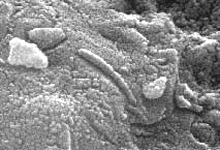 |
Interest in funded new missions to Mars was fanned by the discovery, announced in August 1996, of apparently fossilised Martian bacteria within a meteorite believed to have arrived on Earth from Mars several millions of years ago. |
Chunks of Mars were thrown up by volcanoes and by impacts. The low gravity means that Mars not only loses rocks to space, but each time there is a major disturbance, part of its atmosphere is lost to space too, thus Mars gets smaller and its atmosphere thinner.
At least a dozen meteorites have been found so far on Earth with recognisable Martian origins. The oldest of these had crystallised from magma soon after the formation of Mars and differentiation of the planet into core, mantle and crust. Younger Martian meteorites show that igneous volcanism continued until at least 1.3 thousand million years.
Many of the Martian meteorites show some evidence of interaction with liquid water. Some have igneous minerals with a little water but most have alteration products, especially salts and clays caused by weathering.
Studies of the lightest elements that make up the atmosphere tell us that Mars' atmospheric evolution was very different from that of Earth. Some of the lightest gases from Mars' atmosphere were lost to space due to the smaller size and lighter gravity.
A number of features indicate possible fossils, very tiny, some egg-shaped some tubular, very similar to microscopic fossils of the tiniest, most primitive, bacteria found on Earth. These were found on one of the oldest of the Martian meteorites and suggest that there were life forms existing on Mars more than 3.6 thousand million years ago.
Recent investigations of the life found on Earth in Mars-like conditions - such as the permafrost in Yakutia, shows that life in Martian conditions could be possible. Discoveries of life in extreme conditions of heat or cold on Earth, show that it may even had been possible for primitive bacteria to survive the journey inside a lump of rock from Mars.
Missions to Mars continued:
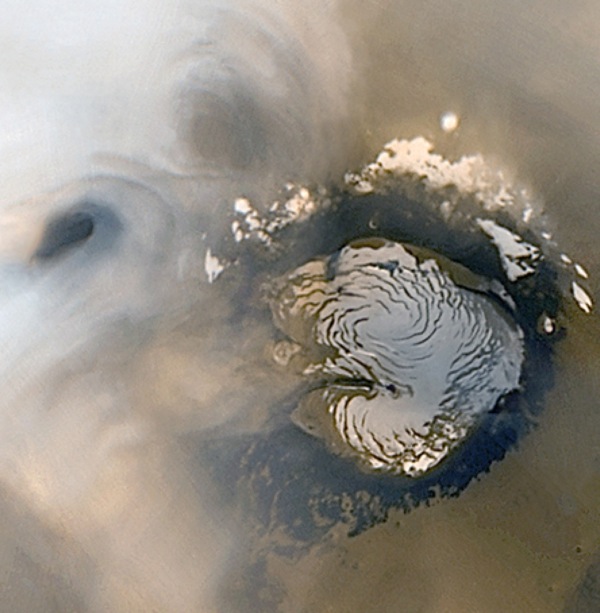 Autumn 1996, saw the launch of the useful Mars Global Surveyor A makeover from the failed Mars Observer and containing the same experiments it surveyed Mars while orbiting around the planet. Still working - this picture showing the North Pole of Mars with clouds was taken November 2006. More information. Mars 96 exploded soon after take off.
Autumn 1996, saw the launch of the useful Mars Global Surveyor A makeover from the failed Mars Observer and containing the same experiments it surveyed Mars while orbiting around the planet. Still working - this picture showing the North Pole of Mars with clouds was taken November 2006. More information. Mars 96 exploded soon after take off.
Pathfinder landed on Mars on 4th July 1997. At first it seemed the Great Martian Ghoul was about again, but after an initial glitch, the Sojourner rover trundled off its ramp and set off to examine the rocks.
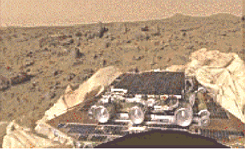
| The landing site has been called the Sagan Memorial Station after the astronomer Carl Sagan who had died just before. The rocks have all been given names, and so have the other features visible in a panoramic photo from the landing site. |
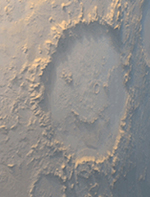 | Launches to Mars are planned about every 26 months when Mars is in the best position relative to the Earth on their orbits. Some interesting features have been observed - many found to be tricks of the light or interpretion. | 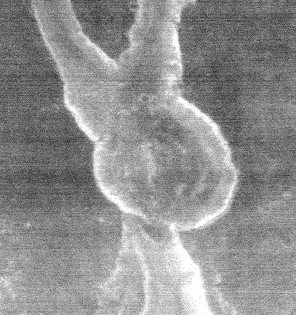 |
The aim orignally was to have a manned mission to Mars by 2019, but one of the many technological problems being grappled with for this two-year mission is the design of an adequate toilet on the spacecraft. Another the mentality of those destined to spend 2 years in space, with return to Earth uncertain.
Robot missions to Mars have been increasingly successful since 1997. With the noteable exception of two failed Nasa missions in 1999, both due to Nasa's failure to check details sufficiently between launch and mismanagement and cost cutting.
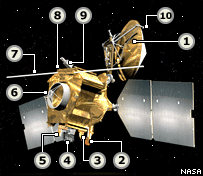 Mars Reconnaissance Orbiter (MRO) launched 12th August 2005. It cost about £397m.
Mars Reconnaissance Orbiter (MRO) launched 12th August 2005. It cost about £397m.
- 3m High-gain antenna
- High-resolution Imaging Science Experiment
- Electra UHF communications relay
- Mars Climate Sounder
- Compact Reconnaissance Imaging Spectrometer for Mars
- Orbit insertion thrusters
- Shallow subsurface radar
- Thrusters
- Optical Navigation camera
- Low-gain antennae
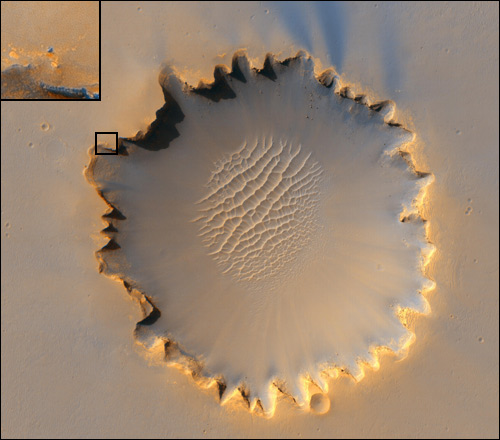
In the picture Opportunity can be seen from the Mars Reconnaissance Orbiter as a dot near the edge of Victoria Crater.
Opportunity still sending back pictures after 5 years, like this one which is a full panorama so you can see part of Opportunity at both ends. The colour has been added and is not real.

History of Mars
Information gathered from the expeditions and from the Hubble space telescope, confirmed that Mars has water. There is frost on its surface and at its polar caps. there are also small clouds in its thin atmosphere. Apparent old river beds show that Mars once had much more water.
The Northern hemisphere is low-lying. Two thirds of Mars is upland in the southern hemisphere. A line of dichotomy divides the old southern cratered surface from the northern newer surface, and goes round the bulge of the volcanic area of Tharsis, the third main physical region of Mars.
The history of Mars has been divided in epochs:
- Early Noachian up to 4.400 million years ago
- Late Noachian to 3.800 million years ago
- Hesperian to 3.500 million years ago
- Early Amazonian to 2.300 million years ago
- Middle Amazonian to 700 million years ago
- Late Amazonian to present.
The main period of cratering stopped in the Hesperian. The rivers date from the Early to Late Noachian. There were huge floods up to the Early Amazonian with lakes and seas. What had happened in that although the small size of Mars did not enable it to hold on to a thick atmosphere for long and much water vapour, water survived as ice under the surface like permafrost. The volcanism on Tharsis caused the floods and it melted the permafrost. It can be seen that lakes and even small seas formed over 3,000 million years ago on Mars. It is possible to see the chaotic areas of terrain where this happened and water was carried in rivers into standing lakes or seas. These areas are the sites of possible early life, which is to be looked for by the next probes to Mars.
More recent surveys of Mars have confirmed that Mars was largely covered by water in the Noachian age.
Update: Results from the Curiosity Rover, show that Mars once had a much thicker atmosphere in its first billion years. It has also found evidence that in the past the environment was more favourable for early forms of microbial life.
The difference between the southern and northern hemisphere of Mars is striking. The northern half of Mars is dominated geologically relatively young, low-lying plains. The southern half has a thicker crust, (discovered by the Mars Global Surveyor), with highlands and is covered by craters. It is clearly much older than the northern hemisphere.
It really looks like Mars was subject to a heavy impact or a number of impacts early on in its formation, in its first 100 million years, which stripped the outer part of the northern hemisphere.
Computer simulations have supported this theory. And it is suggested that the northern crust originates from deep mantle rock which was melted by that impact. The collision would have sent shock waves through the planet which would have caused the magnetic anomalies found in the southern hemisphere. Others have estimated that an object half to two-thirds the size of our Moon, striking the early Mars at an angle of 30 to 60 degrees might have been responsible.
It also seems possible that Mars was impacted by at least one large object estimated to have been as big as Pluto, which not only scraped off a large part of the planet but on fragmenting, may have seeded this early life onto Earth.
Which would make us all Martians.
More information and also.
Links to latest news and information on Mars
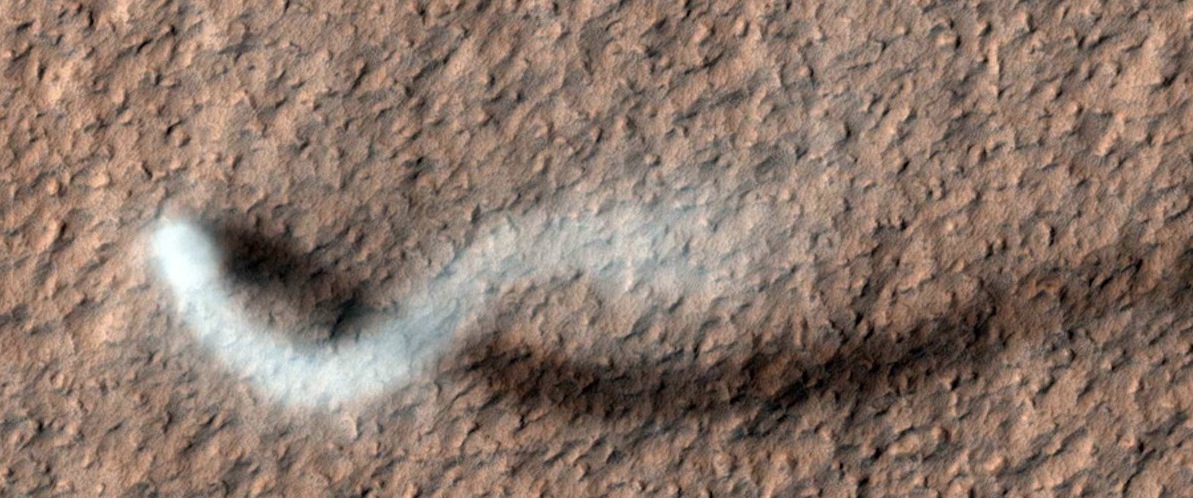
Duststorm on Mars.
| This webpage written, designed and maintained by Heather Hobden | The Cosmic Elk
 |

 (from NASA): A NASA spacecraft, MRO, is providing new evidence of a wet underground environment on Mars that adds to an increasingly complex picture of the Red Planet's early evolution.
(from NASA): A NASA spacecraft, MRO, is providing new evidence of a wet underground environment on Mars that adds to an increasingly complex picture of the Red Planet's early evolution.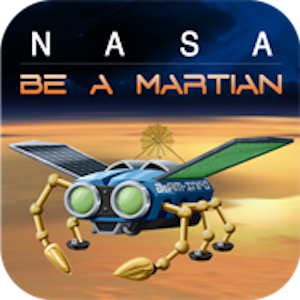
 -The symbol used for Mars on astronomical tables was also the sign used by ironmongers and the sign for "male".
-The symbol used for Mars on astronomical tables was also the sign used by ironmongers and the sign for "male". Through their telescopes it was possible for astronomers to discern features on Mars. Though not very clearly. Darker areas in the centre of Mars can be seen through a small telescope and also the bright white polar ice cap.
Through their telescopes it was possible for astronomers to discern features on Mars. Though not very clearly. Darker areas in the centre of Mars can be seen through a small telescope and also the bright white polar ice cap. Deimos (Terror)
Deimos (Terror) Phobos (Fear)
Phobos (Fear) In 1877, Giovanni Schiaparelli (1835 - 1910) named all the features he observed in Latin, which was internationally acceptable. He saw lines running across Mars from darker areas which he thought were seas. He called the lines Canali (Canals). He made complicated maps of these canals. Other astronomers also started drawing canal systems on Mars, which could not be seen in the photos of Mars. (Such features would never have been visible from Earth even through the most powerful of the telescopes available at the time).
In 1877, Giovanni Schiaparelli (1835 - 1910) named all the features he observed in Latin, which was internationally acceptable. He saw lines running across Mars from darker areas which he thought were seas. He called the lines Canali (Canals). He made complicated maps of these canals. Other astronomers also started drawing canal systems on Mars, which could not be seen in the photos of Mars. (Such features would never have been visible from Earth even through the most powerful of the telescopes available at the time). The idea of canals on Mars triggered off by Schiaparelli was a popular and exciting one in the 19th century. Canals were one of the greatest 19th century technological achievements. Canals meant an advanced civilization of Martians. Once the idea got hold others saw canals on Mars too. The idea was popularised by French writer Camille Flammarion, (1842 - 1925) in a number of books about life on other planets. It inspired an extremely wealthy amateur astronomer Percival Lowell (1855 - 1916). The caption to this picture of the canals on Mars did admit it was not an actual photo but an "artist's impression".
The idea of canals on Mars triggered off by Schiaparelli was a popular and exciting one in the 19th century. Canals were one of the greatest 19th century technological achievements. Canals meant an advanced civilization of Martians. Once the idea got hold others saw canals on Mars too. The idea was popularised by French writer Camille Flammarion, (1842 - 1925) in a number of books about life on other planets. It inspired an extremely wealthy amateur astronomer Percival Lowell (1855 - 1916). The caption to this picture of the canals on Mars did admit it was not an actual photo but an "artist's impression". In 1971, Mars 2's lander failed, but Mars 3 (see picture)was successful. It orbited Mars and launched a lander which transmitted data. But it only lasted for 20 seconds and it was killed off by a dust storm. The orbiters continued to send back pictures but these were spoiled by the massive dust storm which hid the features.
In 1971, Mars 2's lander failed, but Mars 3 (see picture)was successful. It orbited Mars and launched a lander which transmitted data. But it only lasted for 20 seconds and it was killed off by a dust storm. The orbiters continued to send back pictures but these were spoiled by the massive dust storm which hid the features.

 A very interesting feature is what look very much like river valleys. And yet there cannot have been much in the way of surface water on Mars perhaps for at least 3,000 million years, as the atmospheric pressure is just at the point where liquid water cannot be supported.
A very interesting feature is what look very much like river valleys. And yet there cannot have been much in the way of surface water on Mars perhaps for at least 3,000 million years, as the atmospheric pressure is just at the point where liquid water cannot be supported.

 Autumn 1996, saw the launch of the useful Mars Global Surveyor A makeover from the failed Mars Observer and containing the same experiments it surveyed Mars while orbiting around the planet. Still working - this picture showing the North Pole of Mars with clouds was taken November 2006.
Autumn 1996, saw the launch of the useful Mars Global Surveyor A makeover from the failed Mars Observer and containing the same experiments it surveyed Mars while orbiting around the planet. Still working - this picture showing the North Pole of Mars with clouds was taken November 2006. 


